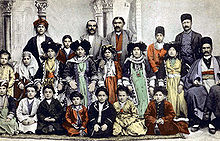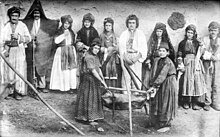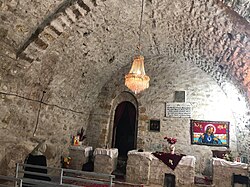Assyrians in Iran
ܐܬܘܪܝܐ ܕܐܝܼܪܵܢ (Syriac) | |
|---|---|
 Iranian Assyrians fromUrmia,Iran | |
| Total population | |
| 20,000[1] | |
| Regions with significant populations | |
| Languages | |
| Neo-AramaicandPersian | |
| Religion | |
| Syriac Christianity |
Assyrians in Iran(Syriac:ܐܬܘܪܝܐ ܕܐܝܼܪܵܢ;Persian:آشوریان ایران), orIranian Assyrians,are anethnicand linguisticminorityin present-dayIran.TheAssyriansof Iran speakAssyrian Neo-Aramaic,aneo-Aramaic languagedescended from the eastern dialects of the oldAramaic languagewith elements ofAkkadian,and areEastern Rite Christiansbelonging mostly to theAssyrian Church of the Eastand also to theAncient Church of the East,Assyrian Pentecostal Church,Chaldean Catholic ChurchandAssyrian Evangelical Church.[2]
They share a common history and ethnic identity, rooted in shared linguistic, cultural and religious traditions, withAssyrians in Iraq,Assyrians in TurkeyandAssyrians in Syria,as well as with theAssyrian diaspora.[2]
The Assyrian community in Iran numbered approximately 200,000 prior to theIslamic Revolutionof 1979.[3]In 1987, there were an estimated 50,000 Assyrians living inTehran.[4]However, after the revolution many Assyrians left the country, primarily for the United States; the 1996 Iranian census counted only 32,000 Assyrians.[5]Current estimates of the Assyrian population in Iran consist of 7,000 combined members of the Assyrian Church of the East and Chaldean Catholic Church in addition to less than 10,000 members of the Assyrian Evangelical Church.[6]
The Iranian capital, Tehran, is home to the majority of Iranian Assyrians; however, approximately 15,000 Assyrians reside in northern Iran, inUrmiaand various Assyrian villages in the surrounding area.[2]To note among theAssyrian diaspora,the Assyrians residing inCaliforniaandRussiatend to be originally fromIran.[7]
TheConstitution of the Islamic Republic of Iran,ratified in 1979, recognizes Assyrians as areligious minorityandethnic minorityand reserves for them one seat in theIslamic Consultative Assembly,the Iranian parliament.[8]As of 2004[update],the seat was occupied byYonathan Betkolia,who was elected in 2000 and reelected in the2004 legislative election.[citation needed]
In 2010, it was estimated that there were only around 5,000 Assyrians left in the historical center of the city of Urmia.[9]
History
[edit]
The Assyrian presence in Iran goes back 4,000 years to ancient times, andAssyriawas involved in the history ofAncient Iraneven before the arrival of the modernIranian peoplesto the region circa 1000 BC. During theOld Assyrian Empire(c.2025-1750 BC) andMiddle Assyrian Empire(1365-1020 BC) the Assyrians ruled over parts ofPre-Iranicnorthern and western Iran. TheNeo-Assyrian Empire(911-605 BC) saw Assyria conquer theIranicPersians,MedesandParthiansinto their empire, together with the ancientpre-IranicElamites,Kassites,ManneansandGutians,and also the IranicCimmeriansofAsia MinorandScythiansof theCaucasus.[10]The home of the Assyrians in Iran has traditionally been along the western shore ofLake Urmiafrom theSalmasarea to the Urmia plain.[11]
After the fall of Assyria between 612 and 599 BC, after decades of civil war, followed by an attack by an alliance of former subject peoples; theMedes,Persians,Babylonians,Chaldeans,ScythiansandCimmerians,its people became an integral part of theAchaemenid Empire(as didAssyriaitself), holding important military, civic and economic positions, and the Achaemenid Persians, having spent centuries under Assyrian domination, were greatly influenced by Assyrian Art and Architecture, modelled their empire upon Assyrian lines, and saw themselves as the successors of the great Assyrian kings. Assyrians are still attested as being extant in the north west of the region during theParthian Empire(160 BC-223 AD) andSassanid Empire(224-650 AD), and throughout theMiddle Ages,where theBukhtishufamily of physicians were held in great regard by the Persian kings.
There were about 200,000 Assyrians in Iran at the time of the 1976 census.[11]Many emigrated after the revolution in 1979, but at least 50,000 were estimated to be still in Iran in 1987.
In 1900, Assyrians numbered over 76,000 in northwestern Iran, constituting over a quarter of the Azerbaijan province's population and were the largest non-Muslim majority inUrmia.Of the 300 villages around Urmia, 60 were exclusively Assyrians and 60 were mixed villages with Assyrian, Armenian, and Azeri communities. Nevertheless, there were over 115 documented Assyrian villages to the west ofLake Urmiaprior to 1918.[10]

During theAssyrian genocide,which took place duringWorld War I,theOttoman Armytogether with alliedKurdishandArabmilitias along thePersian-TurkishandPersian-Iraqi bordercarried out religiously and ethnically motivated massacres and deportations on unarmed Assyrian civilians (andArmenians) both in the mountains and on the rich plains, resulting in the death of at least 300,000 Assyrians.[12]This genocide that started in 1914 was said to be started with the Ottomans’ ‘Jihad’ declaration, apparently solely based on its ethnic and religious differences with the Assyrians because of their belief in Christianity, but actually there was an ambition to extend their ‘holy war’ beyond Assyrian territories to spread its Ottoman influences.[13]
The Ottomans already implemented massacres of several Assyrian tribes from 1843 to 1845, with the motive of taking over their ancestral lands and making them part of the Ottoman Empire. These tribes were particularly the Tiyari, Tkhuma, Jilu and Baz, who all refused Ottoman command. According to British councils, 10,000 Assyrians were massacred already during this time alone. Women and children were taken while Assyrian leaders were cast out from Ottoman forces. Assyrians felt forced to convert to for example Catholicism or Russian Orthodoxy to receive help from the Russian, French or British.[13]
In 1914 alone, they attacked dozens of villages and drove off all the inhabitants of the district ofGawar.The Assyrians defended themselves and for a time successfully repelled further attacks under the leadership ofAgha Petros,seizing control of much of the Urmia region and defeating Ottoman forces and their Kurdish and Arab allies in the process. However, lack of ammunition and supplies, due mainly to the withdrawal ofRussiafrom the war, and the collapse of allied Armenian forces led to their downfall. Massively outnumbered, surrounded, undersupplied and cut off, the Assyrians suffered terrible massacres. These included Assyrian deportations close to the Ottoman-Persian border in January 1915, as well as the invasion of several Assyrian tribes located in the Hakkari mountains. This area already suffered numerous massacres in the 1840s.[13]
By the summer of 1918 almost all surviving Assyrians had fled to Tehran or to existing Assyrian communities or refugee camps in Iraq such asBaqubah.Local Kurds and Arabs and took the opportunity of the last phases of World War I to rob Assyrian homes, murder civilians and leave those remaining destitute. The critical murder that sowed panic in the Assyrian community came when Kurdish militias, underAgha Ismail Simko,assassinated the Patriarch,Shimun XIX Benyamin,on March 3, 1918, under the pretext of inviting him to negotiations, although the Assyrian leaderMalik Khoshabaexacted revenge upon Simko by attacking and sacking his citadel, forcing the Kurdish leader to flee for his life.[11]
Religious communities
[edit]
Most Assyrians in Iran are followers of theAssyrian Church of the East,with a minority of 3,900 following theChaldean Catholic Church.[14]Some also follow Protestant denominations such as theAssyrian Evangelical Church,Assyrian Pentecostal Churchand possiblyRussian Orthodoxydue to aRussian Ecclesiastical Mission in Urmiaduring the 1900s.
Distribution
[edit]- Urmia(Syriac:ܐܘܪܡܝܐ):
- Abajalu,Abdulkandi,Adeh(ܥܕܐ),Aliabad,Aliawach,Alikumi,Alqayeh,Anhar,Ardishai,Armutaghaj,Babarud,Badelbu,Badiki,Balanush,Balu,Borashan,Chamaki,Chamashajan,Charagushi,Charbakhsh(چهاربخش (ارومیه)[fa]),Darbarut,Digala(دیگاله[fa]),Dizataka,Diszgeri,Gawilan,Geogtapa,Lower Gniza,Upper Gniza,Gulpashin/Gulpashan,Gowzgavand,Hesar Babaganja,Ikiaghaj, Iryawa,Jamlawa,Khanishan,Kosi,Lulpa,Mushawa,Nazlu,Piqabaklu,Qala,Qara-Aghaj,Qarajalu,Qaragoz,Qasemlu,Qezel Ashuq,Qurtapa,Saatlu,Sainabad,Sangar,Saralan,Sardarud,Shirabad(ܫܝܪܐܒܕ),Sir,Sopurghan,Taka,Tarmani,Tazakand,Urmia,Vazirabad,Yaghmiralu,Yengija,Zumalan(ܙܘܡܠܢ).
- Margawar:
- Targawar(Syriac:ܬܪܓܘܪ):
- Sumay Baradust:
- Salmas(Syriac:ܣܵܠܵܡܵܣ)::
Churches
[edit]

- Holy Mary (Mart Maryam) Church–Urmia
- St. Mary's Cathedral- Urmia
- St. Cyriacus Church - Urmia
- St. Daniel Church(fa)-Adeh
- St. John Church - Adeh - 1901
- Sts. Peter and Paul Church- Kelisakandi
- St. George Church(fa)-Sopurghan
- St. Peter Church(fa)-Qarabagh
- St. Sarkis Church-Sir
- St. George Church(fa)-Gulpashan
- St. John Church-Gawilan
- Holy Mary Church(fa)–Mavana
- St. Thomas Church-Balowlan
- Assyrian Pentecostal Church– Kermanshah – 1955
- St. Joseph (Mar Yozep) Church– Tehran (Forsat St.) – 1950
- St. Thomas (Mar Toma) Church(fa)– Tehran (Amirabad) – 1967
Famous Assyrians from Iran
[edit]- Hannibal Alkhas, poet and visual artist
- Evin Agassi,music artist
- Ramona Amiri,Miss World Canada 2005
- Ashurbanipal Babilla,actor, theatre director, playwright and visual artist
- Steven Beitashour,MLSplayer
- Patrick Bet-David, entrepreneur, author and YouTuber
- George Bit Atanus,designed the currentAssyrian flagin 1968.
- Bukhtishufamily, famous physicians in the Middle Ages
- Beneil Dariush,MMA fighter
- Jack Douglas,television personality
- Eprime Eshag,Fellow of Wadham College, Oxford
- Alexander L. George,Graham H. Stuart Professor of Political Science Emeritus at Stanford University
- Mar Youhannan Semaan Issayi,Archbishop of Assyro-Chaldean Metropolitan Tehran
- George Malek-Yonan,procured a seat in the Iranian Parliament for Assyrians
- Rosie Malek-Yonan,actress, author and activist
- Younan Nowzaradan,Assyrian-American physician and television personality (My 600-lb Life)
- Andrew David Urshan,evangelist and author
See also
[edit]- Christians in Iran
- Ethnic minorities in Iran
- List of Assyrian settlements
- Religious minorities in Iran
- Russian Ecclesiastical Mission in Urmia
- Da'tid Bahrana
- Urmia Orthodokseta
Notes
[edit]- ^"Iran".U.S. Department of State 2018 Report on International Religious Freedom: Iran.
- ^abcHooglund (2008),pp. 100–101.
- ^"Iran: Assyrian Policy Institute".Assyrian Policy Institute.RetrievedJuly 29,2020.
- ^"ASSYRIANS IN IRAN i. The Assyrian community ( – Encyclopaedia Iranica".www.iranicaonline.org.Retrieved2020-05-20.
- ^Hooglund (2008),pp. 100–101, 295.
- ^"Iran".United States Department of State.Retrieved2020-05-20.
- ^Nisan, Mordechai (2015).Minorities in the Middle East: A History of Struggle and Self-Expression, 2d ed.McFarland. p. 191.ISBN9780786451333.
- ^Hooglund (2008),pp. 128–129.
- ^Nicholas al-Jeloo,Evidence in Stone and Wood: The Assyrian/Syriac History and Heritage of the Urmia Region in Iran.Parole de l'Orient 35 (2010), pp. 1-15.
- ^ab"Settling Into Diaspora: A History of Urmia Assyrians in the United States"(PDF).Archived fromthe original(PDF)on 2018-01-04.Retrieved2015-01-07.
- ^abcIran A Country Study By Federal Research Division - Page 128
- ^David Gaunt,"The Assyrian Genocide of 1915",Assyrian Genocide Research Center,2009
- ^abcTravis, Hannibal (2011). "The Assyrian Genocide, a Tale of Oblivion and Denial".Forgotten Genocides: Oblivion, Denial and Memory.Philadelphia: University of Pennsylvania Press. p. 125.
- ^As of 2014, when combining the populations of all the Iranian diocese together, there are 3,900 followershttp://www.catholic-hierarchy.org/rite/dch2.html
- ^Yonan, Gabriele."Assyrer_heute_Kultur_Sprache_Nationalbew".Academia.edu(in German).
References
[edit]- Hooglund, Eric(2008)."The Society and Its Environment"(PDF).In Curtis, Glenn E.;Hooglund, Eric(eds.).Iran: A Country Study.Area Handbook Series.United States Library of Congress,Federal Research Division(5th ed.).Washington, D.C.:United States Government Printing Office.pp.81–142.ISBN978-0-8444-1187-3.Retrieved13 October2013.
Bibliography
[edit]- Eden Naby, “The Assyrians of Iran: Reunification of a ‘Millat,’ 1906-1914" International Journal of Middle East Studies, 8. (1977) pp. 237–249
- Eden Naby, “The Iranian Frontier Nationalities: The Kurds, the Assyrians, the Baluch and the Turkmens,” Soviet Asian Ethnic Frontiers, ed.by McCagg and Silver (New York, Pergamon Press, 1979).
- Eden Naby, “Christian Assyrian Architecture of Iran,” News – Harvard University Center for the Study of World Religions (Spring 1998) vol. 5, no. 2, p. 7, 10.
- Eden Naby, "Ishtar: Documenting the Crisis in the Assyrian Iranian Community," MERIA 10/4 (2006)https://web.archive.org/web/20090124055153/http://meria.idc.ac.il/journal/2006/issue4/Naby.pdf



